The 5 Least Surprising Toy Recalls of All Time
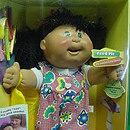
As children prepare to gather around the Christmas tree to open gift-wrapped toys, lets take a moment to remember some of the toy recalls that companies, parents and even children probably should have seen coming a mile away. Because after all, children shouldn't be the only ones who can't sleep the night before Christmas.
The Cabbage Patch Snacktime Kids Doll
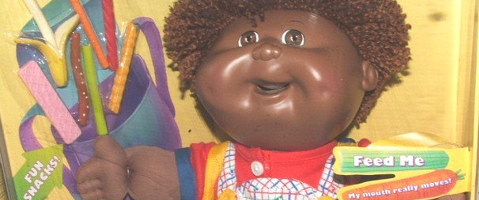
It's not entirely surprising that a Cabbage Patch Kids doll ended up trying to eat children. They've always had lifeless shark's eyes that look ready to roll over white and enter attack mode. Sure, it's outstretched arms look innocently huggable to a child, just like the moist mouth of a Venus fly trap looks like a perfectly good place to land in the final moments of a fly's life.
The doll was unleashed on the masses in the fall of 1996 and more than 500,000 were recalled less than a year later by the U.S. Consumer Product Safety Commission. It was supposed to eat little plastic snack foods through a motorized mouth. Lord knows how the kids got the plastic foods out of them once they were done eating them, but in many unfortunate cases, the doll instead developed a taste for bloody scalps.
Parents reported their children's hair, fingers and skin getting caught in the doll's gullet, which turned out to be so powerful, it could even rip hair clean out of its roots. There were also more difficult to confirm reports of the doll's eyes suddenly turning a bright red and the room temperature dropping 15 degrees Celsius every time you turned it on.
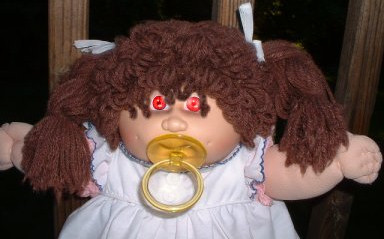
The CPSC ordered a recall and Mattel offered a $40 refund. They did not offer the copy of the Necronomicon that would give parents the power to send the doll back to the bowels of hell from whence it came.
Why they should have known:
Any parent with low-lying, unprotected wall sockets or sleepy pets will tell you that children love to put their fingers into anything and everything their tiny, chubby arms can reach. It's their nature. Because they can't talk and don't have the motor skills or experience to understand pain, the best way they can learn about this weird world they've just entered is to either stick it in their mouths or shove their arms halfway down it. The Cabbage Patch Kids Snacktime Doll was much too big for children to swallow, and it had a motherfucking motorized mouth, so you do the math.
Kinder Chocolate Eggs

Food and toys have a strong relationship. Everybody remembers the sheer joy and excitement of finding the toy surprise in their morning bowl of Lucky Charms. Kids rarely choked on those toys because the boxes had huge flashy advertisements all over them and the toy was usually the first thing they looked for when they tore open the box with their teeth and hands like a lion pouncing on a weak, marshmallow-filled antelope.
Leave it to the Germans to turn childhood joy into unrelenting horror.
Kreiner Imports of Chicago sold the Kinder Egg to stores in the South and Midwest from March to August 1997, just in time for another Christ-based holiday that finds children eating candy-filled chocolate eggs with as much thought and chewing as Pac-Man in attack mode. Unfortunately, Kreiner's chocolate eggs were actually tiny plastic toys with a delicious chocolate shell wrapped around them.

Like a Trojan horse for the Heimlich maneuver, approximately 5,000 death eggs were recalled. The toy manufacturer, the Ferrero Group, blamed the import company for the snafu, claiming that they didn't market their toys in the United States or to children ages 3 and under. These were apparently the toy-filled candy eggs for the discerning adult.
Why they should have known:
It's an edible treat wrapped around an inedible mound of plastic with even tinier bits of choke-tastic plastic encased inside. The edible treat is chocolate, the closest thing children have to heroin. The toy might have been safer on the other side of the Atlantic Ocean, but America's childhood obesity and early on-set diabetes rates should have been a huge red flag to the import company that Americans kids probably wouldn't even take the time to unwrap the thing before shoveling it into their mouths.

And, if there were any warnings about the surprise toy inside, not only would our children's low literacy rates prevent them from reading, but even the parents wouldn't know about it. The label encasing the egg was still written in German when it landed in America, so the product would have been about as safe if the packaging had been in English and read, "Warning: There are no small parts for your children to choke on in here. Viable substitute for baby food."
Sky Dancers

Nothing can be more magical and whimsical to the eyes of the child than a toy that possesses the magic of flight. It's why kids have been making paper airplanes for years. Of course, flying toys lose a little magic when they like to leap up and knock your eye out of its socket.
 Galoob unleashed Sky Dancers in November 1994. It was an unholy alliance between the pretty girlishness of a Barbie doll and the magic of a whirly bird. Children would put the helicopter toy on a mechanical base, pull the cord and watch its foam propeller pull it high into the sky. The company went on to re-release the toy several times as flying dolphins, flowers and ponies--all with different, presumably increasingly gay, names.
Galoob unleashed Sky Dancers in November 1994. It was an unholy alliance between the pretty girlishness of a Barbie doll and the magic of a whirly bird. Children would put the helicopter toy on a mechanical base, pull the cord and watch its foam propeller pull it high into the sky. The company went on to re-release the toy several times as flying dolphins, flowers and ponies--all with different, presumably increasingly gay, names.
Six years later, Hasbro scooped up Galoob and found itself ordering a massive recall when it was learned the magic fairies would randomly fly in any direction at a high rate of speed and bitch slap children and even their parents like a white trash Tinkerbell after a bottle of lukewarm Jack Daniels.
Why they should have known:
To the untrained, uninjured eye, this toy might not seem so harmless on the surface. It's got foam propellers that look about as huggable as a propeller can look and it's too big for a toddler to stuff halfway down their esophagus. However, when activated by a pull cord, it becomes a hyper-kinetic missile searching for the vulnerable parts of anyone within a 3-foot radius. And, since it requires the kid who pulls the chord to stand within a foot of it, there's always a good chance it will be the kid bending his face directly in its whirring propellers of death who will feel the brunt of its fury.
The CSPC received over 150 reports of injuries caused by the toy, including scratched corneas, temporary blindness, broken teeth, face lacerations, a broken rib and even a mild concussion. The toy was pulled off the market before it had a chance to reenact the propeller scene from Raiders of the Lost Ark.
The Easy Bake Oven
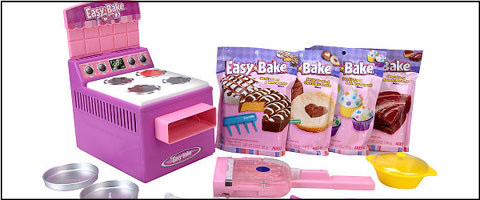
Like the Slinky, Uncle Milty's Ant Farm and Ohio Art's Etch-a-Sketch, the Easy Bake Oven has become a classic toy in the halls of childhood nostalgia. Every little girl or confused young boy had one growing up, or at least the ones who had parents who actually loved them. They could do just about anything a grown up oven could such as bake cakes and cookies, make fudge and brownies and prepare women for a lifetime of soul-crushing indentured servitude to a man who only cares if his meals and his women are as hot and quiet as possible.
But 44 years after Kenner toys created the Easy Bake Oven, it went from a cute childhood plaything that taught children how to give every kid on the block diabetes, to a menacing finger scorching monster.
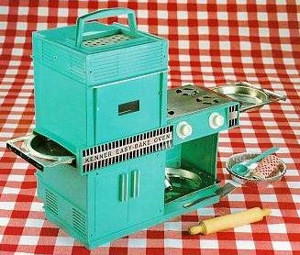
The CSPC announced a recall in February 2007 after 29 reports of burned fingers surfaced and again this past summer when the latest incantation of the toy created by Hasbro baked up 77 incidents of burned fingers, 15 of which went as high as second- and third-degree burns. A 5-year-old girl even had to have part of her finger amputated. Just like a big girl!
Why they should have known:
Forget the fact that the Easy Bake Oven has always been dangerous because it lets children eat icing by the bag. It also lets children stick their fingers in an oven.
Hasbro proudly rolled out their new and improved version of the classic children's toy in 2006 claiming they replaced the light bulb with its own central heating system, according to Hasbro's official Easy Bake Oven timeline.

But ... doesn't it still let children stick their fingers in a fucking oven?
Lawn Darts or Jarts

Lawn darts were introduced in the '60s, a more innocent time when the world did not yet realize that children could be harmed by something as innocuous as a flying metal spike.
The CSPC finally caught on in 1988, when the toys actually killed three children. They issued a recall alert that, not only called for a ban, but also ordered any remaining darts be destroyed on sight like they were bloodthirsty zombies roaming the streets in search of kids to puncture.
Then CSPC Chairwoman Ann Brown reissued the recall alert in May 1997 when one hit a 7-year-old Indiana boy in the head so hard, it pierced his skull. The fan site, Lawn-Jarts.com questions the recall and asks what the big fuss was all about. Cracked.com may not be Consumer Reports, but we have a feeling it has something to do with the dead kids.
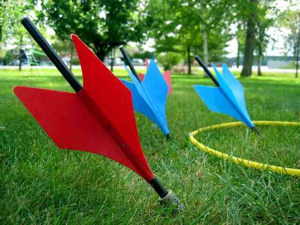
Why they should have known:
This toy went with the strategy of taking darts, a game clearly unsafe for children, and deciding it would be safer if it were 10 times larger, and if the rules were changed so that the target was basically your entire lawn. We're assuming that exploding tip lawn darts were also considered at some point.
It's true that, as lawn dart proponents remind us, the game is perfectly safe if played according to the rules. Of course, the reality is that it takes about three minutes for kids to grow bored with the actual game and for someone to dare someone else to stand over the target and try to catch the dart in his teeth.
Let's face it, if children could be trusted to perfectly obey safety warnings, they could be trusted with flamethrowers, too. Hell, if they could read and obey safety warnings, they'd run the world because half the adults can't even do that.
If you liked this article, check out Danny's rundown of the The 8 Greatest Makeshift Movie Weapons .